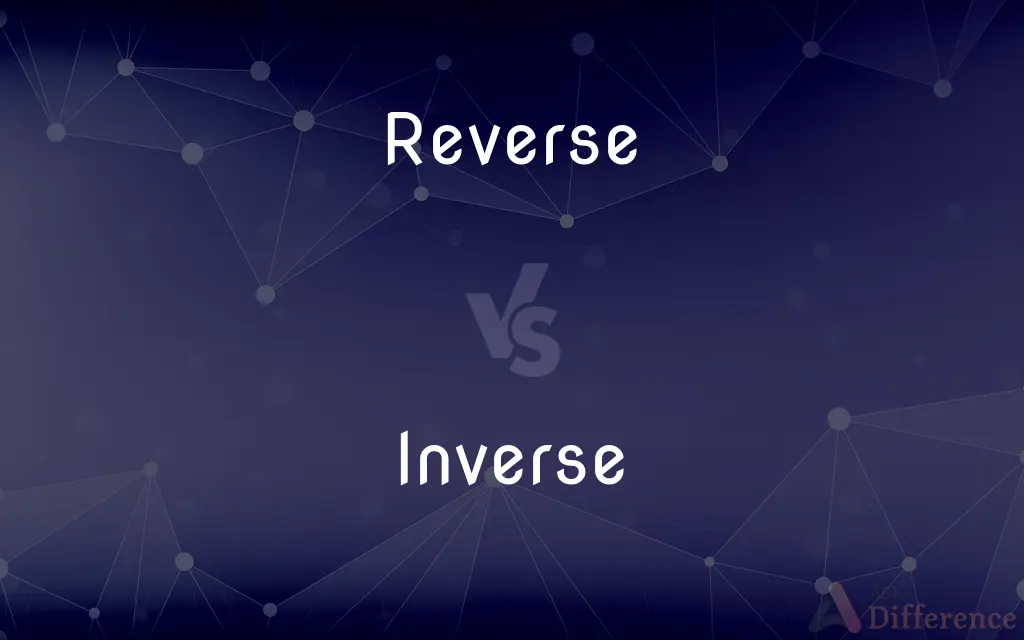Reverse vs. Inverse — What's the Difference?
By Fiza Rafique & Maham Liaqat — Updated on February 24, 2024
Reverse implies moving or turning in the opposite direction, often undoing an action. Inverse refers to a mathematical or relational opposition, where one value increases as another decreases, commonly expressed as an inverse relationship or function.

Difference Between Reverse and Inverse
Table of Contents
ADVERTISEMENT
Key Differences
Reverse is commonly used to describe an action or process that goes in the opposite direction or order from the original. For example, reversing a car means to drive it backward, and reversing a decision means to go back on a previously made choice. It often involves a physical or metaphorical retracing of steps. Inverse, on the other hand, is a term frequently used in mathematics and related fields to describe a relationship between two variables where one is inversely proportional to the other, such as speed being inverse to time in constant motion.
"Reverse" is used more broadly in various contexts, including everyday language, while "inverse" is more specific, often applied in technical, mathematical, and scientific discussions. For instance, the concept of an inverse function in mathematics, which reverses the effect of the original function, showcases the term's specific usage. Conversely, reversing the order of a list involves simply arranging its elements in the opposite sequence, demonstrating a more general application of "reverse."
The distinction also lies in their implications; reversing something can imply a return to a previous state or condition, often seen as undoing or negating an action. In contrast, discussing the inverse relationship between variables highlights a proportional change rather than a direct reversal. For example, in photography, the inverse square law relates the intensity of light to the inverse of the square of the distance from the source, illustrating how inverse relationships can describe natural phenomena.
Understanding the difference between reverse and inverse is crucial in contexts where precision of language is important, such as scientific research, mathematical problem-solving, and technical writing. While both terms imply a form of opposition, "reverse" focuses on direction or order, and "inverse" on mathematical or relational opposition.
Comparison Chart
Definition
Moving or turning in the opposite direction or order.
A mathematical or relational opposition where one value increases as another decreases.
ADVERTISEMENT
Usage Context
Broad, including everyday language and various fields.
More specific, often used in mathematics, science, and technical discussions.
Examples
Reversing a car, reversing a decision.
Inverse relationship in variables, inverse functions in mathematics.
Implications
Often implies a return to a previous state or undoing an action.
Describes proportional changes or mathematical operations that undo each other.
Associated Fields
General use, linguistics, technology.
Mathematics, physics, engineering.
Compare with Definitions
Reverse
Moving backward or in the opposite direction.
The driver put the car in reverse.
Inverse
A relationship where one quantity decreases as another increases.
The inverse relationship between supply and demand.
Reverse
Changing to the opposite position or condition.
The court decided to reverse its earlier decision.
Inverse
The opposite operation in mathematics.
Multiplication is the inverse of division.
Reverse
Undoing a previous action or effect.
The software update was reversed due to glitches.
Inverse
Inversely proportional variables in physics.
Pressure and volume have an inverse relationship in Boyle's Law.
Reverse
Going back in sequence or order.
The video was edited to play in reverse.
Inverse
The reverse function in mathematics.
The inverse of the sine function is arcsine.
Reverse
Turning something inside out or upside down.
She reversed her jacket to reveal a different color.
Inverse
A concept in computing algorithms.
Finding the inverse of a matrix is crucial in linear algebra.
Reverse
Turned backward in position, direction, or order
The reverse side of the poster.
Inverse
Reversed in order, nature, or effect.
Reverse
That which is directly opposite or contrary to something else; a contrary; an opposite.
And then mistook reverse of wrong for right.
To make everything the reverse of what they have seen, is quite as easy as to destroy.
Inverse
Inverted; having a position or mode of attachment the reverse of that which is usual.
Reverse
Change to the contrary;
The trend was reversed
The tides turned against him
Public opinion turned when it was revealed that the president had an affair with a White House intern
Inverse
(Mathematics) Of or relating to an inverse or an inverse function.
Reverse
Moving, acting, or organized in a manner contrary to the usual
In reverse order.
Inverse
An inverted state: a state in which something has been turned (properly) upside down or (loosely) inside out or backwards.
Cowgirl is the inverse of missionary.
321 is the inverse of 123.
Reverse
Opposite, contrary; going in the opposite direction.
We ate the meal in reverse order, starting with dessert and ending with the starter.
The mirror showed us a reverse view of the scene.
Inverse
Opposite in order, relation, or effect; reversed; inverted; reciprocal; - opposed to direct.
Reverse
The side of something facing away from a viewer, or from what is considered the front; the other side.
Inverse
Opposite in nature or effect or relation to another quantity ;
A term is in inverse proportion to another term if it increases (or decreases) as the other decreases (or increases)
Reverse
To cause a mechanism to operate or move in the opposite direction to normal; to drive a vehicle in the direction the driver has the back.
Reverse
To place (a set of points) in the reverse position.
Common Curiosities
Is reversing a process the same as applying an inverse function?
Not exactly; reversing a process can be more general, while applying an inverse function is a specific mathematical operation that undoes the original function.
Is it correct to say a car moves in inverse when it goes backward?
The more common term would be that the car moves in reverse; "inverse" is less likely to be used in this context.
Can a decision be described as having an inverse?
Typically, decisions are described as being reversed rather than having an inverse, as "inverse" is more applicable to mathematical or relational contexts.
How do "reverse engineering" and "inverse operations" differ?
Reverse engineering involves deconstructing a product to understand its design, while inverse operations involve mathematical processes that undo each other.
Can "reverse" and "inverse" be used interchangeably?
While they both imply a form of opposition, they are not interchangeable due to their different contexts and specific meanings.
How does the inverse square law illustrate the concept of "inverse"?
It shows how a quantity (like light intensity) changes inversely with the square of the distance, highlighting an inverse relationship.
Do "reverse psychology" and "inverse thinking" mean the same?
No, reverse psychology involves encouraging a behavior by advocating its opposite, while inverse thinking is more about approaching problems from opposite angles.
How do you find the inverse of a function?
To find the inverse of a function, swap the x and y variables and solve for y, assuming the function meets the criteria for having an inverse.
How does the concept of "inverse" apply in photography?
In photography, the inverse square law applies to the relationship between light intensity and distance from the light source.
Is there an inverse of every mathematical function?
Not every function has an inverse; a function must be bijective (both injective and surjective) to have an inverse.
Can a video game feature both reverse and inverse elements?
Yes, a game could feature reverse gameplay mechanics (like rewinding time) and inverse relationships (like decreasing health increasing difficulty).
Can "inverse" refer to a direct opposite?
"Inverse" typically refers to a mathematical or relational opposite, rather than a direct opposite, which is more often described as "reverse" or "contrary."
Is the concept of "inverse" relevant in everyday life?
Yes, understanding inverse relationships can help in comprehending various phenomena, from economics to physics.
Can "reverse" apply to non-physical concepts?
Yes, "reverse" can apply to abstract concepts, like reversing a policy or decision, not just physical actions or movements.
What is an example of an inverse relationship in economics?
In economics, an example would be the inverse relationship between interest rates and bond prices.
Share Your Discovery

Previous Comparison
Pathology vs. Cytology
Next Comparison
Sweatshirt vs. PulloverAuthor Spotlight
Written by
Fiza RafiqueFiza Rafique is a skilled content writer at AskDifference.com, where she meticulously refines and enhances written pieces. Drawing from her vast editorial expertise, Fiza ensures clarity, accuracy, and precision in every article. Passionate about language, she continually seeks to elevate the quality of content for readers worldwide.
Co-written by
Maham Liaqat















































